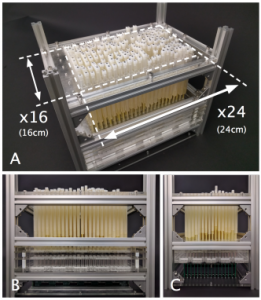 In a paper entitled “Dynablock: Dynamic 3D Printing for Instant and Reconstructable Shape Formation,” a group of researchers look at 3D printing in a new way. “Dynamic 3D Printing” is described as a process that “assembles an arbitrary three-dimensional shape from a large number of small physical elements.” It combines the capabilities of 3D printing and shape displays, in that it can generate “abritrary and graspable” 3D shapes while allowing shapes to be rapidly formed and reformed. Dynablock is the researchers’ prototype of a dynamic 3D printer, and it can form a 3D shape in mere seconds by assembling 3,000 9mm blocks.
In a paper entitled “Dynablock: Dynamic 3D Printing for Instant and Reconstructable Shape Formation,” a group of researchers look at 3D printing in a new way. “Dynamic 3D Printing” is described as a process that “assembles an arbitrary three-dimensional shape from a large number of small physical elements.” It combines the capabilities of 3D printing and shape displays, in that it can generate “abritrary and graspable” 3D shapes while allowing shapes to be rapidly formed and reformed. Dynablock is the researchers’ prototype of a dynamic 3D printer, and it can form a 3D shape in mere seconds by assembling 3,000 9mm blocks.
The researchers describe their vision of 3D printing as an interactive medium. The idea is that the 3D printer takes only seconds to assemble an object, which can then be just as quickly disassembled and the components used to form something new.
“For example, such a 3D printer could be used in a Virtual Reality or Augmented Reality application to dynamically form a tangible object or controller to provide haptic feedback and engage users physically,” the researchers suggest.
Other applications could include educational models for children, such as molecular or architectural models, or means for designers to show a product to clients and interactively change the product’s design while the clients watch.
“In this vision, Dynamic 3D printing is an environment in which the user thinks, designs, explores, and communicates through dynamic and interactive physical representation,” the researchers state.
Their design for dynamic 3D printing involves two key components: a parallel assembler and a rapid connection and disconnection mechanism. Taking inspiration from DLP 3D printing, their assembly method forms entire layers in parallel rather than assembling each individual element in sequence. A fast connection and disconnection method allows layers to be quickly stacked into a stable shape.
Dynablock’s shapes are made with 9mm blocks, which connect to neighboring blocks with embedded magnets. The hardware uses a 24 x 16 pin-based shape display as a parallel assembler. 3,072 blocks are stacked atop the shape display, and motorized pins push up blocks to assemble the object layer by layer. As the blocks are pushed up and out of the assembler, they connect with their neighbors via the magnets, forming an object. Because of weaker vertical magnetic connections, the blocks can disconnect vertically to form overhangs. The process takes only seconds, and the objects can be disassembled to form new ones.
Four properties are given for dynamic 3D printing: it is immediate, reconstructable, forms arbitrary shapes, and forms graspable objects. Four challenges are also mentioned: resolution, speed, scalability and stability. The researchers go on to describe in detail how they built the parallel assembler and connection and disconnection mechanism, keeping the properties and challenges in mind.
They also describe a few potential applications, such as an intriguing idea for an interactive textbook. A student could be reading a textbook explaining the aerodynamics of an airplane. The student would then push a “render” button and the book would immediately generate a model of an aircraft. This is only one of the many ideas that dynamic 3D printing could be used to implement. The system is currently just a prototype, and the researchers point out several areas for further work and improvement, but the framework is strong for a new, different method of 3D printing.
“In the future, we envision that a dynamic 3D printer could become an interactive medium, in which the user can think, design, explore, and communicate through dynamic and interactive physical representation,” the researchers conclude.
Authors of the paper include Ryo Suzuki, Junichi Yamaoka, Daniel Leithinger, Tom Yeh, Mark D. Gross, Yoshihiro Kawahara and Yasuaki Kakehi.
Discuss this and other 3D printing topics at 3DPrintBoard.com or share your thoughts below.
Subscribe to Our Email Newsletter
Stay up-to-date on all the latest news from the 3D printing industry and receive information and offers from third party vendors.
Print Services
Upload your 3D Models and get them printed quickly and efficiently.
You May Also Like
The Dental Additive Manufacturing Market Could Nearly Double by 2033, According to AM Research
According to an AM Research report from 2024, the medical device industry, specifically in dentistry, prosthetics, and audiology, is expected to see significant growth as these segments continue to benefit from...
Heating Up: 3D Systems’ Scott Green Discusses 3D Printing’s Potential in the Data Center Industry
The relentless rise of NVIDIA, the steadily increasing pledges of major private and public investments in national infrastructure projects around the world, and the general cultural obsession with AI have...
AM Research Webinar Explores Continuum’s Sustainable Metal Additive Manufacturing Powders
Metal additive manufacturing (AM) powder supplier Continuum Powders is working to develop solutions that empower industries to reduce waste and optimize their resources. An independent life cycle assessment (LCA) of...
3D Printed Footwear Startup Koobz Lands $7.2M in Seed Round
California-based Koobz is focused on reshoring the U.S. footwear supply chain with advanced manufacturing processes, including 3D printing. The startup just announced that it has added $6 million to its...


































